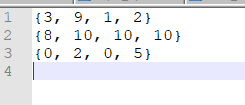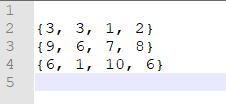This works on V 12.1 on windows
SetDirectory[NotebookDirectory[]]
open = OpenAppend["ESTgrowth.txt", FormatType -> InputForm];
Do[
newdata = RandomInteger[{0, 10}, 4];
Write[open, newdata],
{n, 1, 3}
];
Close[open];
Now the file looks like this

To read it back, we must make a list of lists. This is done by replacing each "\n" with "," and adding "{" at start and adding "}" at end of the string. Only after that, we can convert it to Mathematica experssion.
dataBack = Import["ESTgrowth.txt"];
dataBack = StringReplace[dataBack, "\n" -> ","];
dataBack = StringInsert[dataBack, "{", 1];
dataBack = StringInsert[dataBack, "}", -1];
dataBack = ToExpression[dataBack]
(* {{3, 9, 1, 2}, {8, 10, 10, 10}, {0, 2, 0, 5}} *)
If we now run the above code all over again, it still works, and the file now looks like this

And data is read back OK as
{{3, 9, 1, 2}, {8, 10, 10, 10}, {0, 2, 0, 5}, {0, 7, 5, 6}, {9, 8, 8,
8}, {8, 7, 8, 2}}
Update
For V 11.3, it has an extra "\n" at start of file. So for V 11.3 the following should work
open = OpenAppend["ESTgrowth.txt", FormatType -> InputForm];
Do[
newdata = RandomInteger[{0, 10}, 4];
Write[open, newdata],
{n, 1, 3}
];
Close[open];
Now
dataBack = Import["ESTgrowth.txt"];
dataBack = StringReplace[dataBack, "\n" -> ","];
(*this line below only needed for V 11.3 *)
dataBack = StringDrop[dataBack, 1]; (*delete the extra "," we added*)
dataBack = StringInsert[dataBack, "{", 1];
dataBack = StringInsert[dataBack, "}", -1];
dataBack = ToExpression[dataBack]
Gives
{{1, 8, 8, 7}, {0, 7, 8, 0}, {9, 10, 6, 6}}
Update
It looks like OP is till seeing an issue on V 11.3, but I am not able to duplicate it. Here are the steps again showing result of each step. On windows 10.
Here is showing step-by-step the above on V 11.3

open = OpenAppend["ESTgrowth.txt", FormatType -> InputForm];
Do[
newdata = RandomInteger[{0, 10}, 4];
Write[open, newdata],
{n, 1, 3}
];
Close[open];

dataBack = Import["ESTgrowth.txt"];
InputForm[dataBack]

dataBack = StringReplace[dataBack, "\n" -> ","];
InputForm[dataBack]

dataBack = StringDrop[dataBack, 1]; (*delete the extra "," we added*)
InputForm[dataBack]

dataBack = StringInsert[dataBack, "{", 1];
InputForm[dataBack]

dataBack = StringInsert[dataBack, "}", -1];
InputForm[dataBack]

dataBack = ToExpression[dataBack];
InputForm[dataBack]
gives
{{3, 3, 1, 2}, {9, 6, 7, 8}, {6, 1, 10, 6}}












{Import[...]}? $\endgroup$In[23356]. Simply do not use that one. I added this since you said you had extra "\n" at the front. Which I also saw on my end when using V 11.3. But it looks like now you do not get that extra "\n". So simply do not use that extra step we added. Try it again, but without stepIn[23356]where it drops first letter, and it should work. $\endgroup$